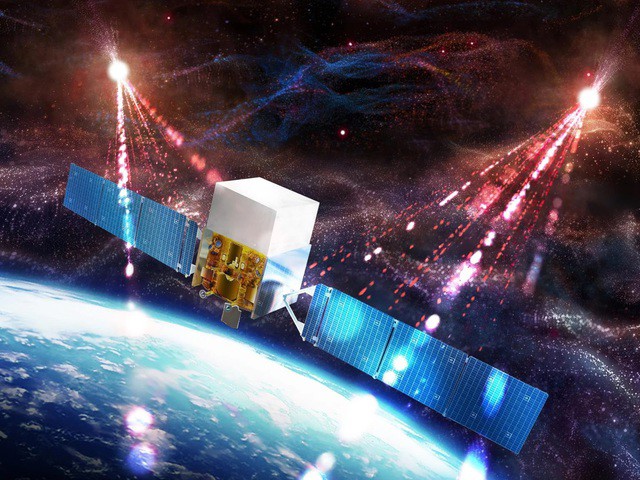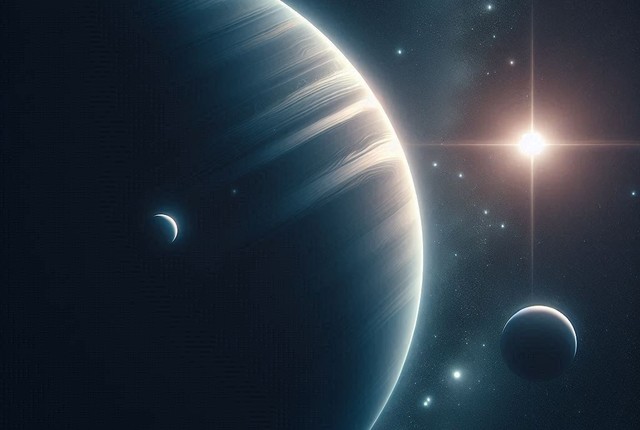NASA's Fermi Gamma-ray Space Telescope has just captured what's being described as an "energy peak" in the universe.
According to SciTech Daily, the energy source mentioned above is called BOAT by astronomers - the brightest gamma-ray burst (GRB) of all time.

NASA's Fermi Gamma-ray Space Telescope has collected data on an energy source more powerful than anything ever recorded - Photo: NASA
BOAT, formerly known as GRB 221009A, exploded on October 9, 2022, and quickly overwhelmed most orbiting gamma-ray detectors, including those at Fermi.
This means that incredibly powerful instruments like Fermi have yet to measure the most intense part of the energy burst, which is believed to be the brightest to appear in Earth's skies in 10,000 years.
Now, an international team of scientists has solved some of the mystery.
They focused on finding the answer to the main question: What caused this energy explosion?
The most likely source is the annihilation of electrons and their antimatter counterparts called positrons, according to co-author Gor Oganesyan from the Gran Sasso Institute of Science and Gran Sasso National Laboratory (Italy).
"When an electron and a positron collide, they annihilate each other, creating a pair of gamma rays with an energy of 0.511 MeV," Dr. Oganesyan explained.
If this explanation is correct, to produce the emission line peaking at 12 MeV, the annihilation particles must be traveling toward us at about 99.9% the speed of light.
These parameters are quite consistent with the hypothesis of the most common source that can emit gamma radiation, which is the death of supergiant stars.
In theory, supermassive stars that run out of fuel can collapse and form a rapidly rotating black hole.
Matter falling into the black hole powers jets of particles that head in opposite directions, traveling through the outer layers of the star at nearly the speed of light. We detect GRBs when one of these jets is pointed almost directly toward Earth.
The above theory has been proposed for a long time, but there are still a few points that scientists do not clearly understand.
So Fermi's BOAT data promise to provide even more clues about the deadly energy outbursts of massive stars.
And it also shows that NASA's Fermi is well-placed to provide some more similar examples, should similar energy bursts occur in the future.
Researchers from the Flatiron Institute and a handful of independent scientists have teamed up to identify a planet called TOI-4633 C — also known as Percival — that lies entirely within the Goldilocks habitable zone of its parent star TOI-4633 A.
TOI-4633 A is a G-type star located in a binary system 310 light-years away.
The remaining star in the system is TOI-4633 B, which is slightly smaller than TOI-4633 A and orbits this star and its two planets in a large orbit.

Planet Percival is located in the habitable zone of its parent star, has a sibling planet and possibly several "habitable moons" orbiting it - Photo AI: Anh Thu
Back to TOI-4633 C, according to NASA it is a gas giant exoplanet with a mass of about 0.387 Jupiters, or 123 times the mass of Earth. The radius of this planet is about 3.2 times larger than Earth.
TOI-4633 C is 0.847 AU (astronomical units, equivalent to the Sun-Earth distance, about 150 million km) from its parent star and takes 271.9 days to complete one orbit around the star.
NASA's TESS satellite found the planet first, but research led by the Flatiron Institute has shed some light on its mystery, most notably confirming it as a world suitable for life.
One problem is that TOI-4633 C is more like Neptune than Earth, a gas planet with no solid surface and an atmosphere that could be thick with water vapor, hydrogen and methane.
This would slightly reduce the chances of life existing. Or if it did, it would have to be a form of life very different from Earth life.
However, many studies show that such long-period planets are likely to possess many moons with surfaces that could support life.
So even if life does not exist directly on this planet, it could still have many habitable moons like Jupiter or Saturn in the Solar System.
The remaining planet in the system, TOI 4433 B, is even larger than this potentially habitable world, with a radius of 13.7 times that of Earth, making it larger than Jupiter (which has a radius 11 times that of Earth).
Scientists say they will have to wait another 30 years for the two stars in the TOI-4433 AB system to be far enough apart to better determine the structure of the star system and also learn more about the interesting planet Percival.

